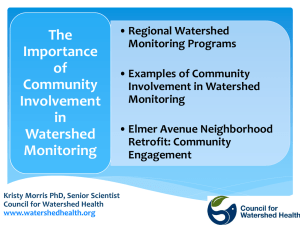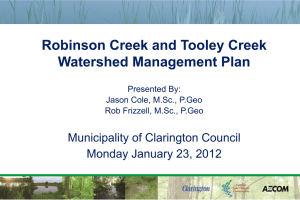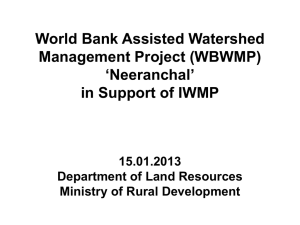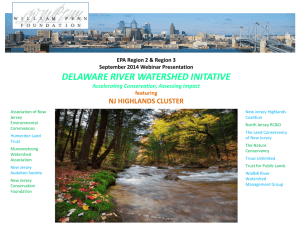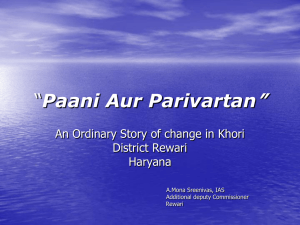Ground Water Quality - Raritan Basin Watershed Management Project
advertisement
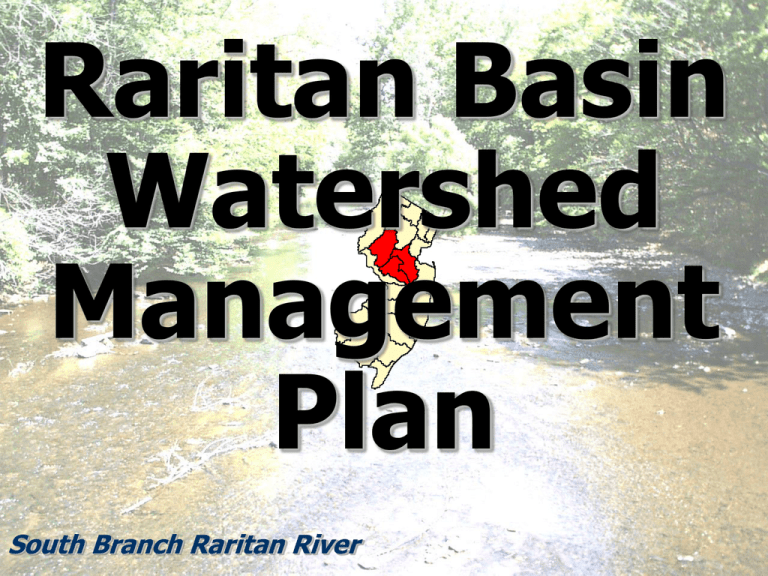
Raritan Basin Watershed Management Plan South Branch Raritan River Presentation Overview Why do we have a Raritan Plan? What does the Raritan Plan envision? What are the real water issues in the Raritan Basin, and how does the plan address them? What are the next steps? What is the worth of water? when you haven’t a drop to drink when you have too many drops to drink when the drops can’t get to you when you wouldn’t want the drops even if they could get to you What is a Watershed? •Area of land that drains into a body of water (river, lake, stream or bay) •Watersheds define the quantity and quality of water available for human and ecosystem use Why do we manage watersheds? •To improve water quality •To protect natural resources • To protect water quantity • To meet public needs for watershed resources Lower Raritan - Edison Township The Raritan Basin Watershed Largest river basin entirely within NJ 1,100 square mile area Includes 3 Watershed Management Areas Encompasses parts of 7 Counties and 100 Municipalities Basin Streams Much of mainstem Raritan River is tidal North and South Branch Raritan to northwest Mainstem Raritan and South River to southeast Millstone River to south central Topography and Geology Highlands - 17% (Ridges of hard rock; Valleys of limestone and shale) Piedmont - 61% (shale & sandstone with hills of Diabase and Basalt) Coastal Plain – 22% (Unconsolidated deposits of sand/clay) Why Create a Watershed Plan? Clean Water Laws – – – – – – Surface water quality Ground water quality Supporting ecosystems Supporting human uses Point & nonpoint sources Habitat degradation Ecosystem Protection – – Freshwater wetlands Streams and flood plains Water Supply Laws – – – – – – – – Reservoirs Aquifers Public supplies Domestic supplies Industrial uses Agricultural uses Recreational uses Ecosystem protection RARITAN BASIN WATERSHED MANAGEMENT PROJECT NORTH & SOUTH BRANCH RARITAN WMA RARITAN BASIN COUNCIL LOWER RARITAN WMA WORK GROUPS BASIN EDUCATION & OUTREACH COMMITTEE TECHNICAL ADVISORY COMMITTEE Attributes of the Raritan Plan: Raritan Basin Council A Watershed Management Plan “describes how a watershed will be taken from its existing condition to a desirable future condition.” The plan should be: Resource-oriented Objective-oriented Change-oriented Raritan Plan Components Executive Summary Vision Goals & Objectives Characterization & Assessment of Key Issues Implementation Strategies Implementation Challenges & Recommendations Evaluation Method Planning and Decision-Making Process Summary “Watershed management, while seen as a technical exercise, is primarily a political exercise.” Tom Schueler, Center for Watershed Protection In order to protect the water, we must begin with the land” “ Parris Glendening, Governor of Maryland, 2002 Purpose of the Raritan Plan Cooperation of public and private interests to remedy past damages, prevent future harm to water resources, and ensure that human uses of Basin resources remain within sustainable levels that protect Basin ecosystems Vision Statement We envision a Raritan River Basin in which the following occurs as quickly as possible but no later than within a generation: Overcoming the Past Managing the Future Taking Responsibility Maintaining Vigilance Vision Statement Overcoming the Past: The impacts of existing and former land and water uses and pollutant discharges are remedied so that water quality, water supplies, flood plains, aquatic habitats and, indeed, the total capacity of Raritan River Basin as a water resource are restored to health. Vision Statement Continued Managing the Future: Future land uses, pollutant discharges and water uses are carefully managed and remain within the long-term sustainable resource levels. Land uses and people are not placed at risk from flooding and other natural disasters. Land preservation efforts protect the vital water resources of the Raritan River Basin. Vision Statement Continued Taking Responsibility: All individuals living and working in the Raritan River Basin understand and take responsibility for the impacts of their actions on the Raritan River Basin, and for being part of the solution. Vision Statement Continued Maintaining Vigilance: Decision makers in the public, private and non-profit sectors learn from the past, anticipate the future, understand the dynamics of our complex region, and act in concert to protect the vital natural resources of the Raritan River Basin If the Plan = Action, Who Acts? Implementation relies on voluntary action by many interests: – NJDEP — grants, acquisition, regulations and permits – State/Federal agencies — fund, build, operate projects – County and municipal government—ordinances, acquisition, manage land, build & operate projects – Non-governmental groups—implement projects and educate the public – Citizens and businesses—manage buildings and lands, and take personal action “The push for perspective must be tied to a push for institutions to implement the results.” “The lesson of the Everglades: This stuff is really tough.” G. Edward Dickey, Ph.D. Former Acting Assistant Secretary for the Army Characterization & Assessment Identify & compare current status and trends to desired conditions – – What IS? What SHOULD BE? Many uses – guides and justifies effort, focuses thinking, helps avoid the “red herring” issues Population Changes Clearly shows development intensity in the Raritan Basin So What Are the Major Water Issues? Surface water pollution Loss of riparian areas Biological impairment of streams Ground water losses Water supply limitations Stormwater impacts Surface Water Pollution Assessment of Surface Water Quality Status and Loads Objectives • • • Water quality and trends Pollutant loads of permitted and non-permitted sources Relations to land use and stream flow Pike Run – Millstone Watershed Management Area Stream Classifications NJDEP Surface Water Classifications (provide basis for water quality and uses of surface waters) – – – – Green – Trout Production Red – Trout Maintenance Blue – Non-trout Yellow – Saline Quality and Flow USGS looked at flow versus concentration, loads, seasonal patterns, etc. What Are the Raritan Basin’s Big Water Quality Issues? • Most frequent quality concerns (percent exceeding criteria) – Phosphorus 32% – Fecal Coliform 29% – Trout Water Temp 12% • Impaired stream habitat • Pesticides – human health and aquatic life • No known violations for industrial solvents (VOCs) Eutrophication Pollutant Loadings – NPS vs. PS Suspended Solids – Most of load from NPS, generally more than 2/3 of load Dissolved Solids – Most of load from NPS except very low flow conditions Nitrates – Most of load from point sources (PS) except high flow conditions Phosphorus – Some streams, most of load from PS at low flow, but NPS at high flow. Some watersheds all loads from NPS Relation to Land Use Forested Land – – Higher dissolved oxygen Lower excess nutrients, suspended sediment & temperature Developed Land – – Lower dissolved oxygen Higher excess nutrients, suspended sediment, temperature & sodium Best Stream Quality Mulhockaway Creek, Spruce Run & Lamington River – North Branch Raritan at Chester – Best overall quality for the most parameters Lowest Ammonia-Nitrogen Manalapan Brook & Upper Millstone River – Lowest Sodium Worst Stream Quality Millstone, Neshanic and Mainstem Raritan Rivers – South Branch Raritan – Total Dissolved Solids, Alkalinity Lamington and North Branch Raritan River – Worst overall quality for most parameters Chloride Matchaponix Brook – Total Dissolved Solids, Low pH Trends of Future Concern Total Dissolved Solids Chloride Sodium Key Goals for Surface Water Quality To achieve appropriate water quality so that ecological balance and appropriate uses of the watershed are maintained Nonpoint source loads that allow fishable/swimmable waters, healthy aquatic ecosystems, water-based recreation, and a quality water supply How Will We Get There? Regulatory actions to restore impaired waters Improved stormwater controls Subwatershed approaches Lake restoration projects Increased performance standards for highly sensitive watersheds Correction of in-stream erosion problems Integrated Crop Management Loss of Riparian Areas Riparian Area A – Trout Stream B/C – Wildlife Passage Corridor D – Freshwater Wetlands E – Wetlands Transition Area F – 100 Year Floodplain G – Steep Slope H - Soils Riparian Area Conversion Historical riparian area may have looked like this Early Settlement: Forested to Ag Recent Pattern: Forested and Ag to Urban Riparian Area Conversions Shows percent of subwatersheds converted to nonnatural land cover Bar chart – status of subwatersheds by Management Area Key Goals for Riparian Areas Open water and other wetland resources protected and restored to improve functions and ecosystem services Sufficient preserved open space and stewardship activities to fully protect water resources How Will We Get There? Preserve riparian areas through acquisition Preserve through development design Reforestation of damaged riparian areas Special focus on headwaters protection Stream Impairment Stream Biology NJDEP biological assessments in Raritan, 1993 & 1998 Level of moderate impairment decreased but severe impairment increased slightly Non-impaired streams mostly in forested areas – no change overall Headwaters Streams Streams with no tributary streams flowing to them Smallest streams, lowest flows, most vulnerable Weakest regulation, but constitute 50 percent of all mapped stream miles Critical to larger streams: provide critical flow and biological support Key Goals for Stream Impairment No degradation or destruction of headwaters Restoration of degraded headwaters Restore and protect the integrity of stream channels affected by scour, erosion and sedimentation from stormwater flows How Will We Get There? Comprehensive stream stabilization/restoration projects for subwatersheds of concern “Adopt-a-stream” and “River Friendly” programs Control new stormwater flows to prevent stream scouring and erosion Ground Water Losses Ground Water Recharge Change 136 subwatersheds – 130 showed losses Majority of losses in 0-10% range Some losses in 10-25% range 6 subwatersheds show minimal gains (<3.5%), probably from re-growth of vegetated areas Ground Water Quality Contaminated sites grouped around Route 1, Route 22 and Raritan River in northeast Basin 180 within well head protection areas (of 980 contaminated sites) Septic System Density Number of septic systems each watershed can handle without high risk of harming aquifers Varies within each watershed – analysis gives average lot sizes during average conditions Septic System Capacity Average density of septic systems by subwatershed; Nitrate target of 5.5 mg/L Lower Raritan – Average lot size range from 2.4 to 11 acres/septic system Millstone – 2.6 to 3.9 Upper Raritan – 1.6 to 3.4 Controversial – what risk levels and standards are appropriate? Key Goals for Ground Water Adequate ground water recharge and baseflow to maintain all future water needs The quality of ground water will be maintained, improved and protected How Will We Get There? Ground water recharge restoration projects Ensure no net loss of ground water recharge Treatment and use of contaminated supplies Sustainable septic system densities Septic system management Water Supply Limitations Droughts Water Use Know your aquifers Know the demands Understand the future Plan for it! US Forest Service map Water Supply Surface Water – – – – NJWSA 225 MGD New Brunswick 8 MGD Others – limited Constructed facilities Ground Water – – – – 80-135 MGD total Amount uncertain Naturally available Not concentrated Population Density Change Population growth by percent isn’t the only issue Population density changes provide a different approach to viewing watershed stresses Sewer Service Areas Existing Sewered Areas and Areas Approved for Future Sewer Service From Wastewater Management Plans Eastern area – discharges to Bay State Plan Relationships to Sewer Service Areas What sewer areas in PA 4 and 5? Centers or sprawl? What PA 1 and 2 lands in septic system areas? What conflicts with water resources? Transportation Urban Land within 1 Mile of Highways: 80% of all 1986 urban land within 1 mile 59% of new urban land between 1986 and 1995 within 1 mile Key Goals for Water Supply A sustainable and dependable water supply for human and ecological needs How Will We Get There? Establish subwatershed water budgets and keep uses within sustainable levels Equitable allocation practices Better local drought response practices Conservation and alternative sources for local water supplies New surface water facility by 2040 Stormwater Impacts Stormwater Systems: Old and New Older developments -stormwater systems have few or no controls Recent development -better controls but generally not up to most current standards Maintenance is always an issue This diagram shows how development and its corresponding increase in impervious cover disrupts the natural water balance. In the post-development setting, the amount of water running off the site is dramatically increased. Center for Watershed Protection “Impacts of Urbanization” Impaired Streams Floods Impervious Surfaces Darker color = higher impervious surface Densest development follows State/ Federal highway orientation Suburban residential scattered Closely related to watershed health Land Uses Eastern Raritan Basin more urbanized than western areas Relationship of urban uses to stormwater generation Impervious surfaces important but not the only issue Key Goals for Stormwater Quality of stormwater runoff will not cause or contribute to surface water pollution Watershed-based management of stormwater and flood damage reduction Minimized flood damages through environmentally protective approaches Stormwater systems that produce no further deterioration of receiving water bodies How Will We Get There? Watershed-based stormwater management plans and regulatory controls Watershed-based flood damage reduction using nonstructural approaches where possible Targeted control of stormwater in areas of localized flooding concern Control new development – no harmful effects Focus on both volume and rate of runoff Strategies with Multiple Benefits Open Space Preservation Open space for water resources – not for ball fields Map shows critical lands for water resources – 40% of Basin land area Preserve through acquisition, donation, easement, and better development design Improved Development Practices Development Location Development Layout Development Design Development Practices Development Density Redevelopment Low Impact Site Design Prince Georges County, Maryland Restoration & Stabilization Flow restoration Riparian area restoration Stream channel restoration Reforestation Recharge restoration Organizing for Implementation NJDEP/NJWSA Project completed in 2002 Implementation depends on decisions by governments, non-profits, other stakeholders Partnership approach (Basin and Watershed Management Areas) will continue Very small coordinating staff planned No duplication of programs by regional coordinating staff – empower local efforts! Some Final Thoughts Watershed management isn’t guaranteed to be successful Include components that can succeed even if NJDEP changes focus Not just complying with laws – we can achieve much more than mere compliance Project Contacts New Jersey Water Supply Authority, Watershed Protection Unit 732-356-9344 NJDEP-Division of Watershed ManagementNorthern Bureau 609-633-3812 www.raritanbasin.org Raritan Basin Project Partners NJ Department of Environmental Protection NJ Water Supply Authority Characterization & Assessment Project Team – – – – – – – North Jersey Resource Conservation & Development Council Rutgers Center for Environmental Communication South Branch Watershed Association Stony Brook-Millstone Watershed Association United States Geological Survey USDA-Natural Resources Conservation Service Upper Raritan Watershed Association
